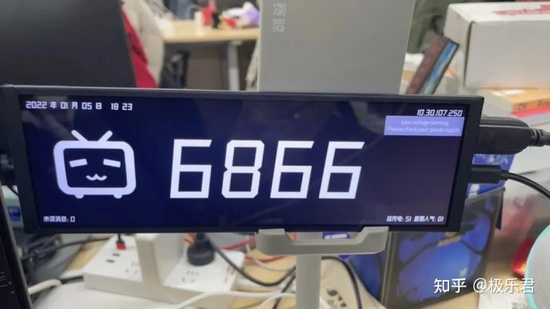一、Introduction
LightGBM是扩展机器学习系统。是一款基于GBDT(梯度提升决策树)算法的分布梯度提升框架。其设计思路主要集中在减少数据对内存
一、Introduction
LightGBM是扩展机器学习系统。是一款基于GBDT(梯度提升决策树)算法的分布梯度提升框架。其设计思路主要集中在减少数据对内存与计算性能的使用上,以及减少多机器并行计算时的通讯代价
1 LightGBM的优点
- 简单易用。提供了主流的Python\C++\R语言接口,用户可以轻松使用LightGBM建模并获得相当不错的效果。
- 高效可扩展。在处理大规模数据集时高效迅速、高准确度,对内存等硬件资源要求不高。
- 鲁棒性强。相较于深度学习模型不需要精细调参便能取得近似的效果。
- LightGBM直接支持缺失值与类别特征,无需对数据额外进行特殊处理
2 LightGBM的缺点
- 相对于深度学习模型无法对时空位置建模,不能很好地捕获图像、语音、文本等高维数据。
- 在拥有海量训练数据,并能找到合适的深度学习模型时,深度学习的精度可以遥遥领先LightGBM。
二、实现过程
1 数据集介绍
本数据用于LightGBM分类实战。该数据集共有9881场英雄联盟韩服钻石段位以上的排位赛数据,数据提供了在十分钟时的游戏状态,包括击杀数,金币数量,经验值,等级等信息。
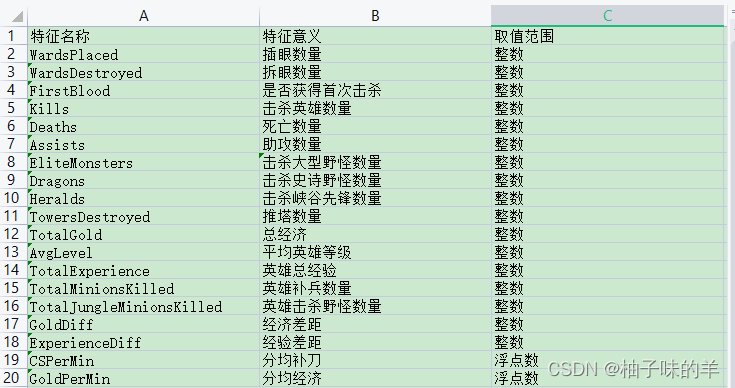
2 Coding
#导入基本库
import numpy as np
import pandas as pd
## 绘图函数库
import matplotlib.pyplot as plt
import seaborn as sns
#%% 数据读入:利用Pandas自带的read_csv函数读取并转化为DataFrame格式
df = pd.read_csv('D:\Python\ML\data\high_diamond_ranked_10min.csv')
y = df.blueWins
#%%查看样本数据
#print(y.value_counts())
#标注特征列
drop_cols=['gameId','blueWins']
x=df.drop(drop_cols,axis=1)
#对数字特征进行统计描述
x_des=x.describe()
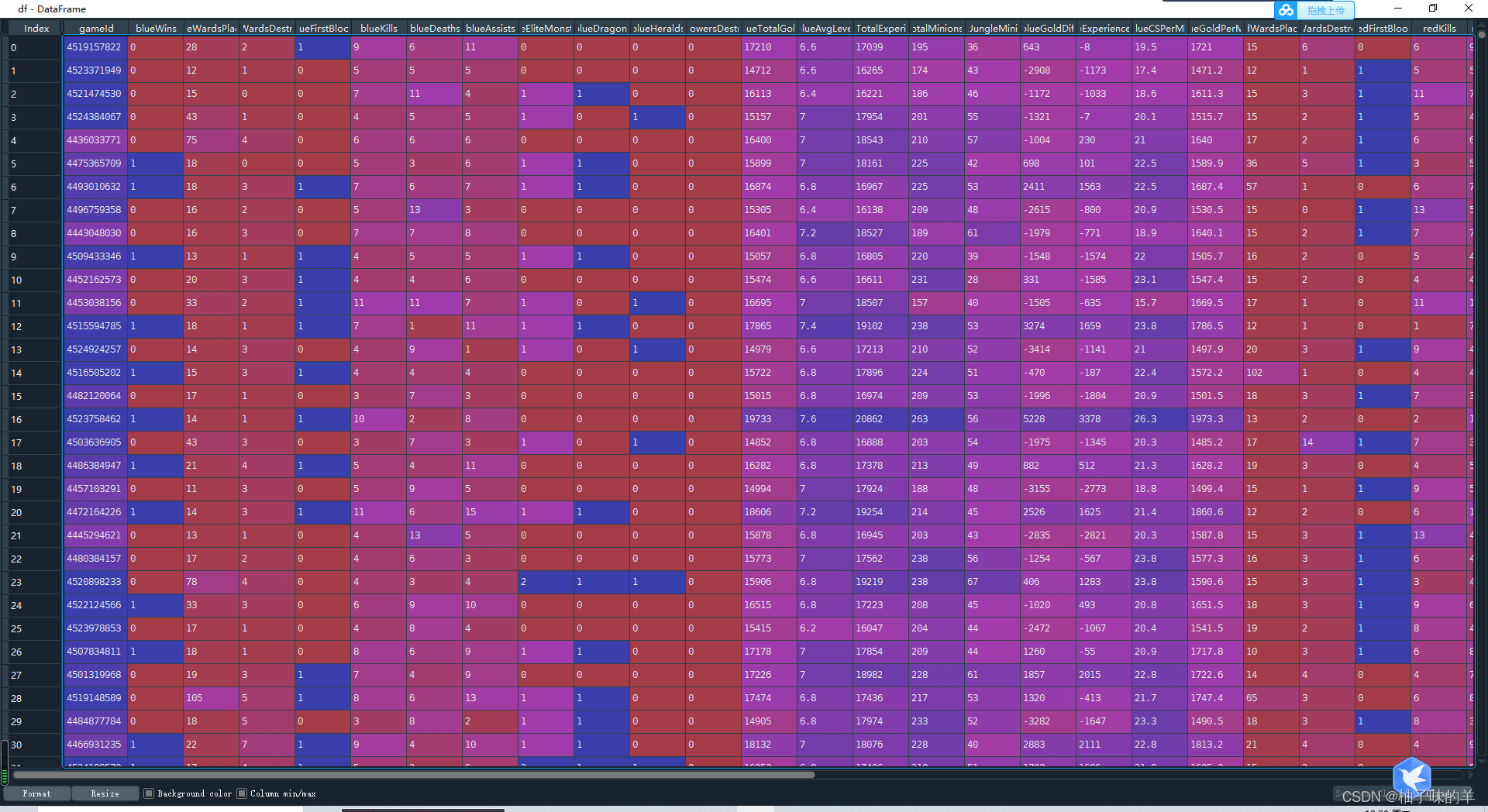

#%%去除冗余数据,因为红蓝为竞争关系,只需知道一方的情况,对方相反因此去除红方的数据信息
drop_cols = ['redFirstBlood','redKills','redDeaths'
,'redGoldDiff','redExperienceDiff', 'blueCSPerMin',
'blueGoldPerMin','redCSPerMin','redGoldPerMin']
x.drop(drop_cols, axis=1, inplace=True)
#%%可视化描述。为了有一个好的呈现方式,分两张小提琴图展示前九个特征和中间九个特征,后面的相同不再赘述
data = x
data_std = (data - data.mean()) / data.std()
data = pd.concat([y, data_std.iloc[:, 0:9]], axis=1)#将标签与前九列拼接此时的到的data是(9879*10)的metric
data = pd.melt(data, id_vars='blueWins', var_name='Features', value_name='Values')#将上面的数据melt成(88911*3)的metric
fig, ax = plt.subplots(1,2,figsize=(15,8))
# 绘制小提琴图
sns.violinplot(x='Features', y='Values', hue='blueWins', data=data, split=True,
inner='quart', ax=ax[0], palette='Blues')
fig.autofmt_xdate(rotation=45)#改变x轴坐标的现实方法,可以斜着表示(倾斜45度),不用平着挤成一堆
data = x
data_std = (data - data.mean()) / data.std()
data = pd.concat([y, data_std.iloc[:, 9:18]], axis=1)
data = pd.melt(data, id_vars='blueWins', var_name='Features', value_name='Values')
# 绘制小提琴图
sns.violinplot(x='Features', y='Values', hue='blueWins',
data=data, split=True, inner='quart', ax=ax[1], palette='Blues')
fig.autofmt_xdate(rotation=45)
plt.show()
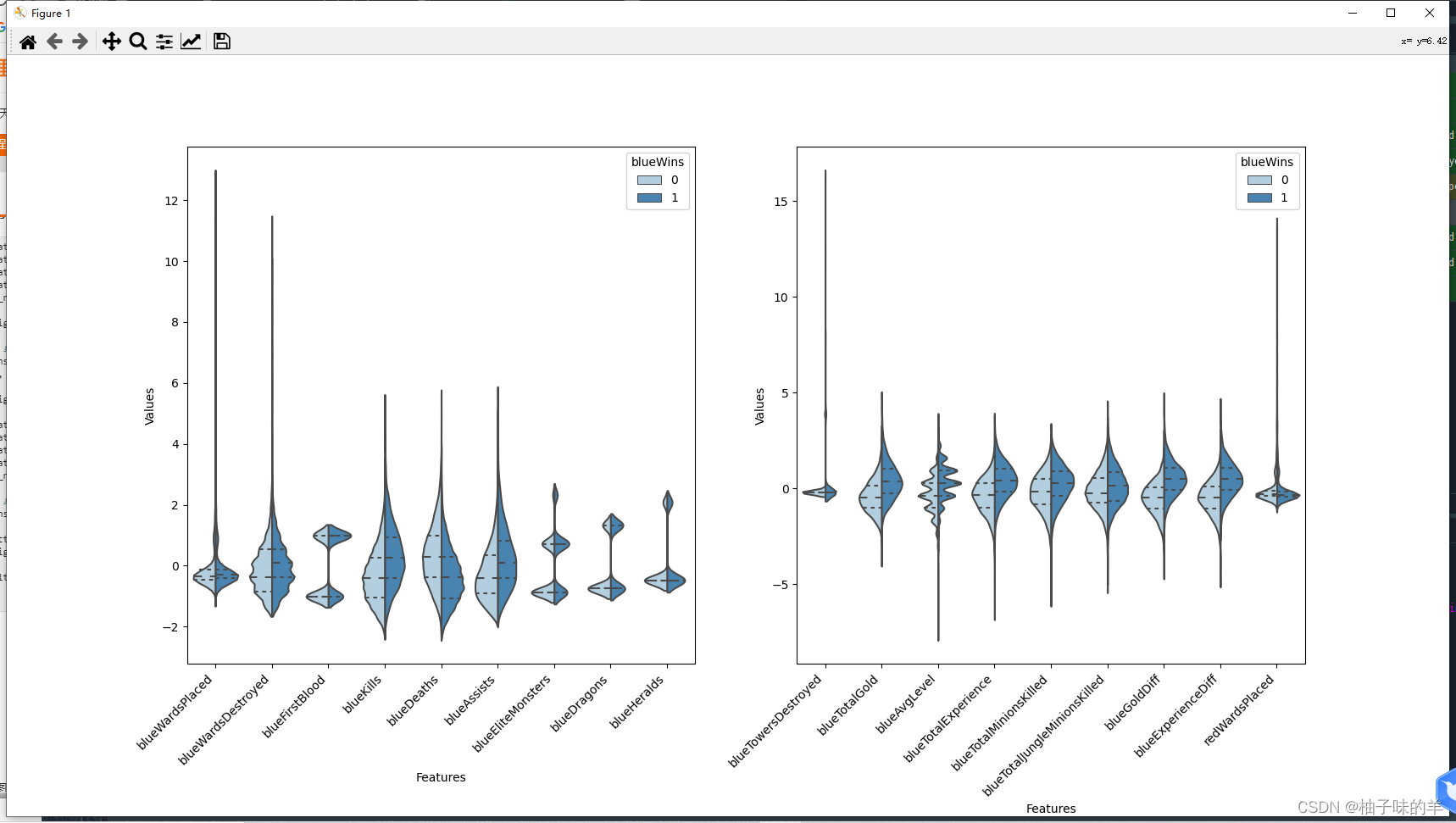
#%%画出各个特征之间的相关性热力图 fig,ax=plt.subplots(figsize=(15,18)) sns.heatmap(round(x.corr(),2),cmap='Blues',annot=True) fig.autofmt_xdate(rotation=45) plt.show()
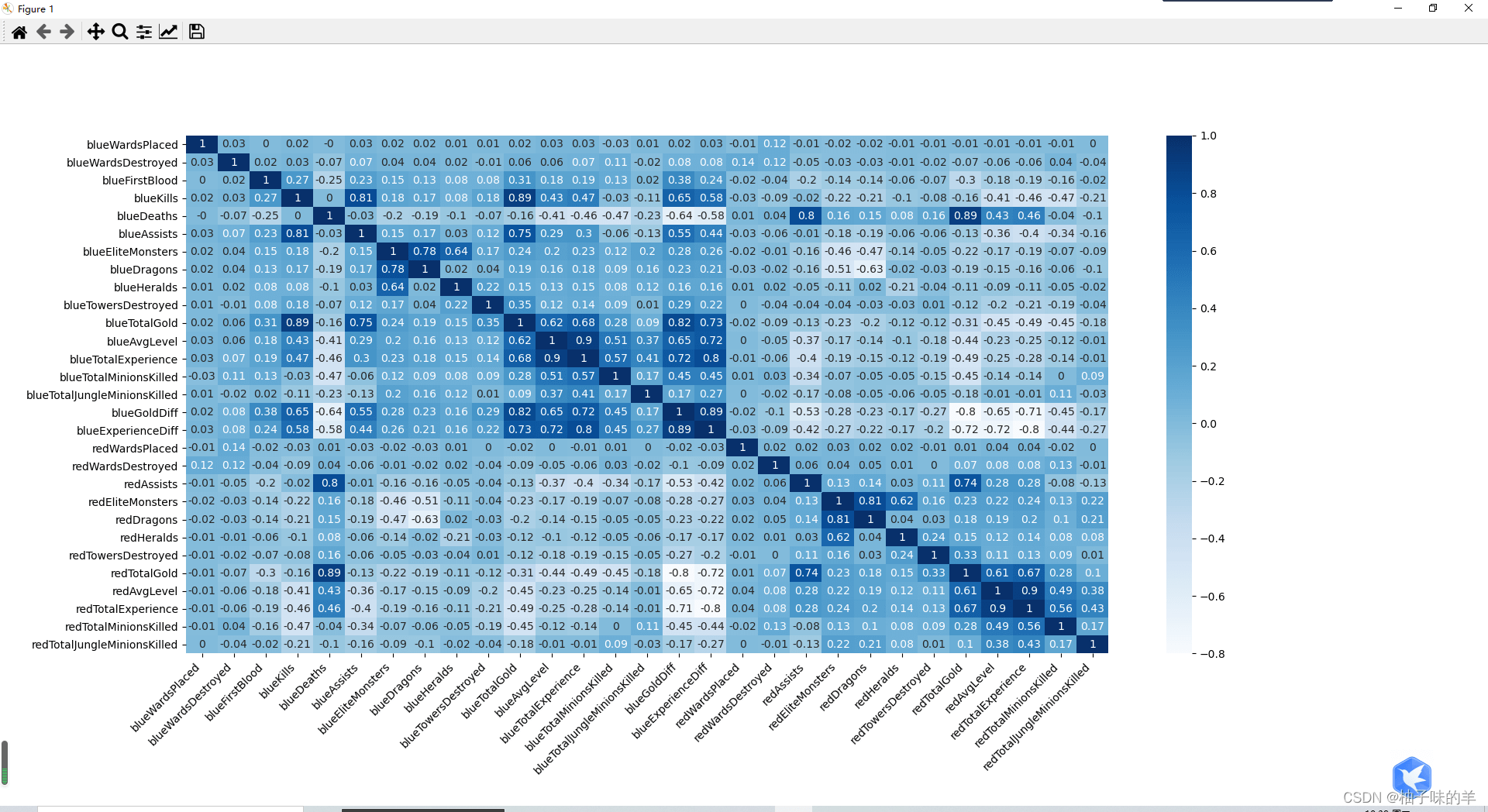
#%%根据上述特征图,剔除相关性较强的冗余特征(redAvgLevel,blueAvgLevel) # 去除冗余特征 drop_cols = ['redAvgLevel','blueAvgLevel'] x.drop(drop_cols, axis=1, inplace=True) sns.set(style='whitegrid', palette='muted') # 构造两个新特征 x['wardsPlacedDiff'] = x['blueWardsPlaced'] - x['redWardsPlaced'] x['wardsDestroyedDiff'] = x['blueWardsDestroyed'] - x['redWardsDestroyed'] data = x[['blueWardsPlaced','blueWardsDestroyed','wardsPlacedDiff','wardsDestroyedDiff']].sample(1000) data_std = (data - data.mean()) / data.std() data = pd.concat([y, data_std], axis=1) data = pd.melt(data, id_vars='blueWins', var_name='Features', value_name='Values') plt.figure(figsize=(15,8)) sns.swarmplot(x='Features', y='Values', hue='blueWins', data=data) plt.show()
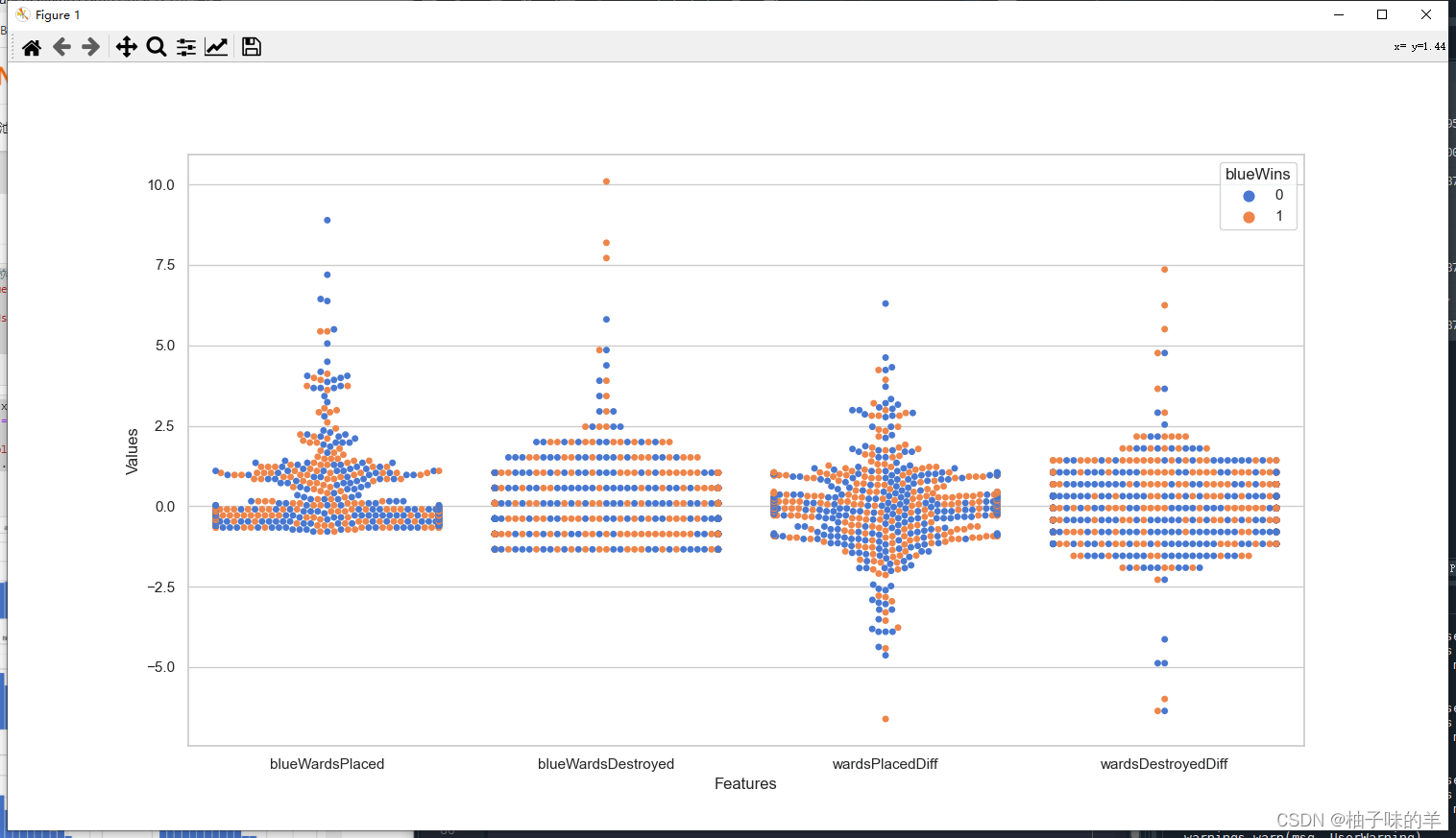
#%%由上图插眼数量的离散图,可以发现插眼数量与游戏胜负之间的显著规律,游戏前十分钟插眼与否对最终的胜负影响不大,故将这些特征去除
## 去除和眼位相关的特征
drop_cols = ['blueWardsPlaced','blueWardsDestroyed','wardsPlacedDiff',
'wardsDestroyedDiff','redWardsPlaced','redWardsDestroyed']
x.drop(drop_cols, axis=1, inplace=True)
#%%击杀、死亡与助攻数的数据分布差别不大,但是击杀减去死亡、助攻减去死亡的分布与缘分不差别较大,构造两个新的特征
x['killsDiff'] = x['blueKills'] - x['blueDeaths']
x['assistsDiff'] = x['blueAssists'] - x['redAssists']
x[['blueKills','blueDeaths','blueAssists','killsDiff','assistsDiff','redAssists']].hist(figsize=(15,8), bins=20)
plt.show()
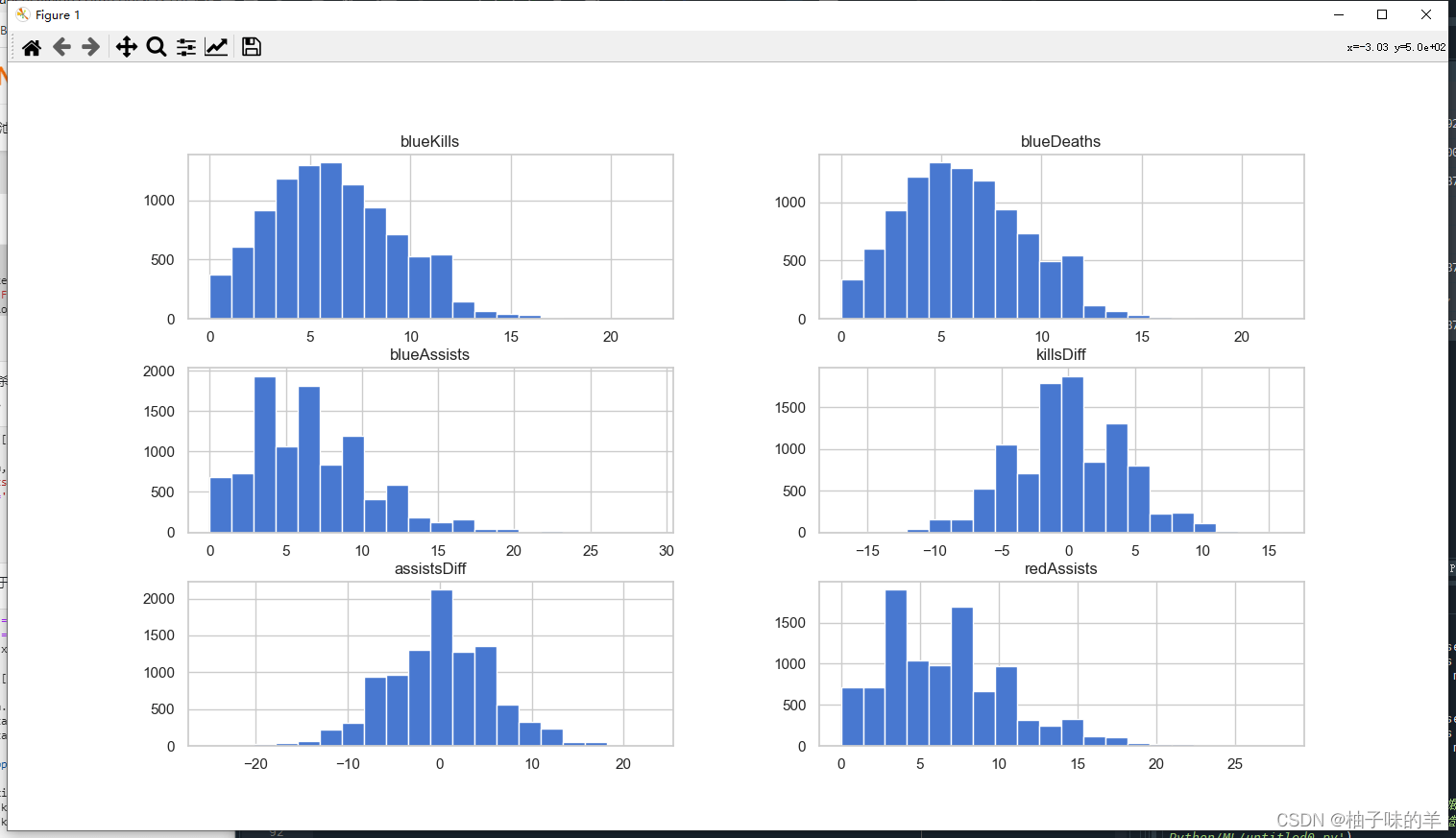
#%% data = x[['blueKills','blueDeaths','blueAssists','killsDiff','assistsDiff','redAssists']].sample(1000) data_std = (data - data.mean()) / data.std() data = pd.concat([y, data_std], axis=1) data = pd.melt(data, id_vars='blueWins', var_name='Features', value_name='Values') plt.figure(figsize=(10,6)) sns.swarmplot(x='Features', y='Values', hue='blueWins', data=data) plt.xticks(rotation=45) plt.show()
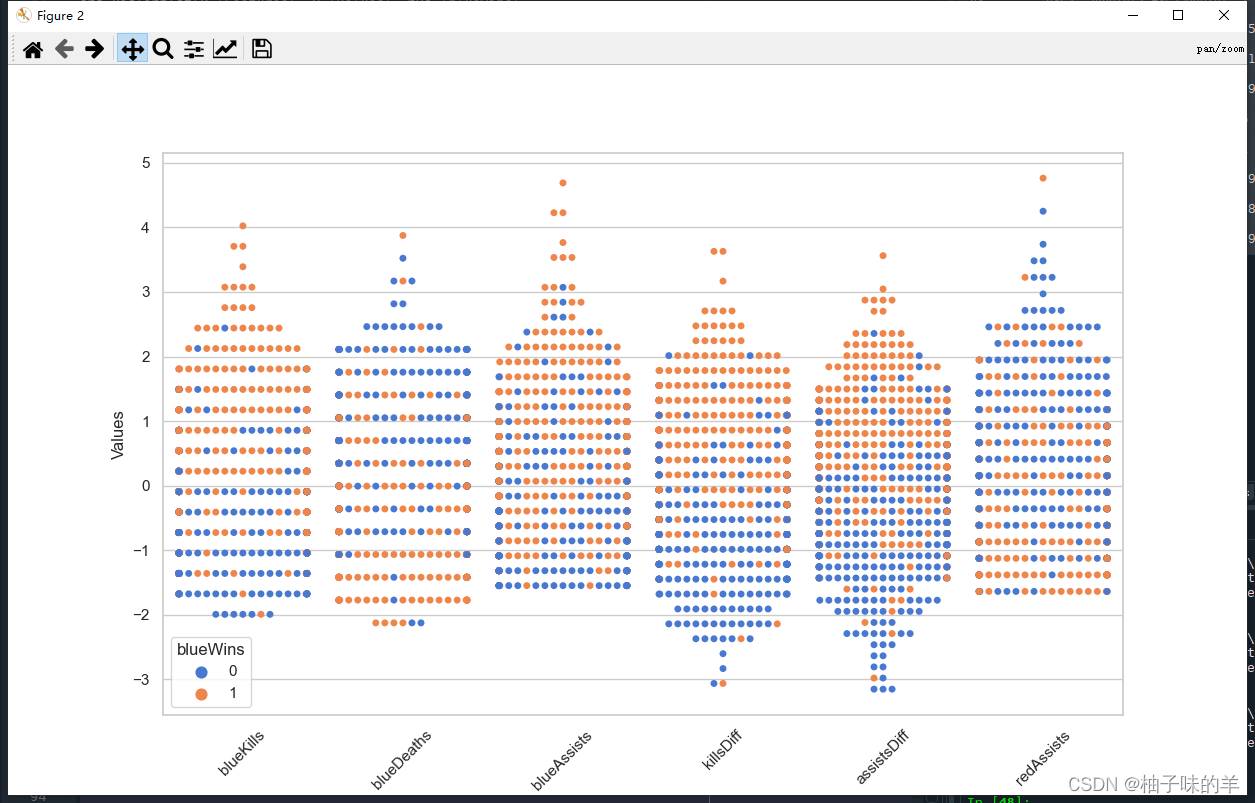
#%%
data = pd.concat([y, x], axis=1).sample(500)
sns.pairplot(data, vars=['blueKills','blueDeaths','blueAssists','killsDiff','assistsDiff','redAssists'],
hue='blueWins')
plt.show()
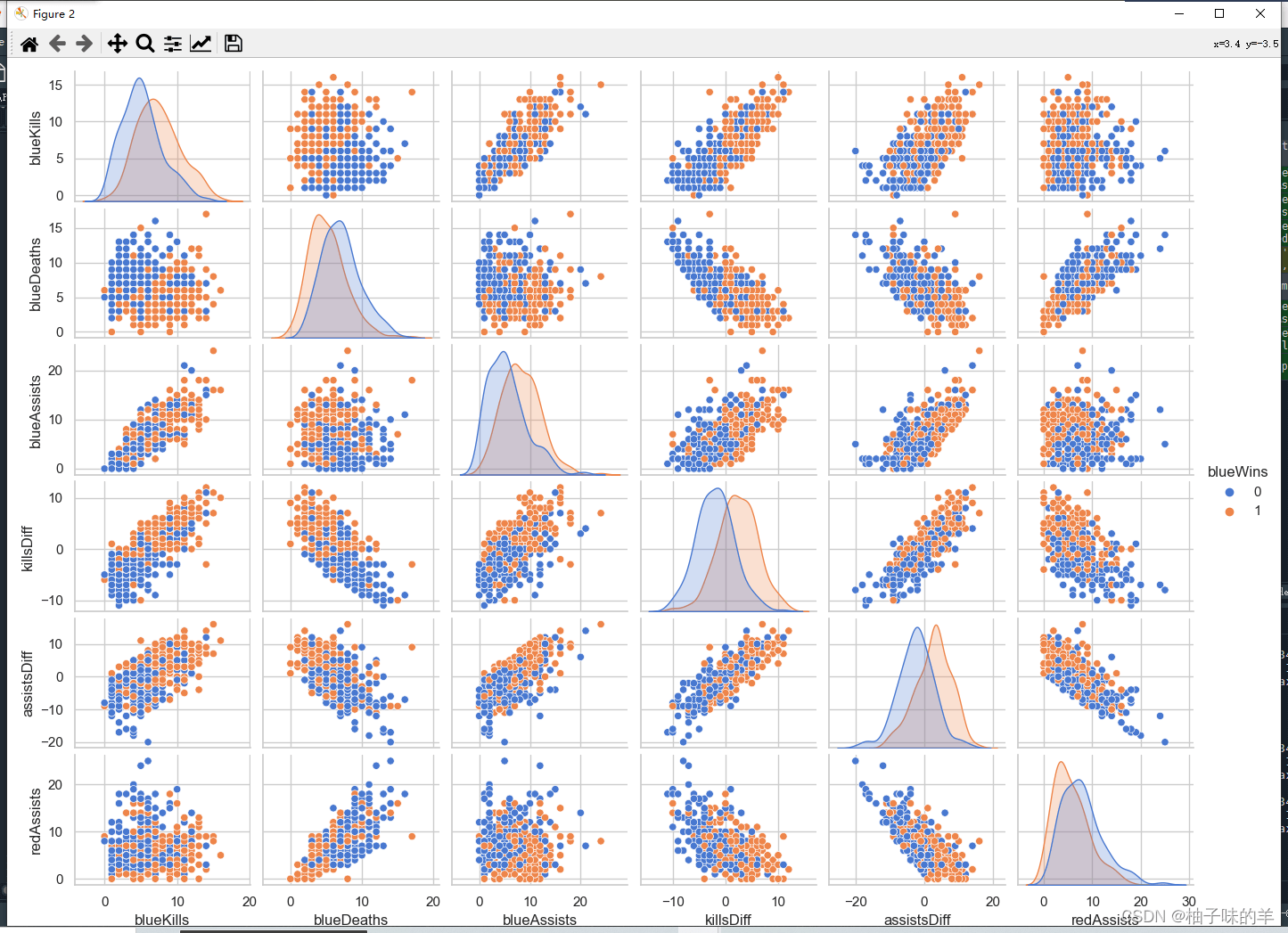
#%%一些特征两两组合后对于数据的划分有提升 x['dragonsDiff'] = x['blueDragons'] - x['redDragons']#拿到龙 x['heraldsDiff'] = x['blueHeralds'] - x['redHeralds']#拿到峡谷先锋 x['eliteDiff'] = x['blueEliteMonsters'] - x['redEliteMonsters']#击杀大型野怪 data = pd.concat([y, x], axis=1) eliteGroup = data.groupby(['eliteDiff'])['blueWins'].mean() dragonGroup = data.groupby(['dragonsDiff'])['blueWins'].mean() heraldGroup = data.groupby(['heraldsDiff'])['blueWins'].mean() fig, ax = plt.subplots(1,3, figsize=(15,4)) eliteGroup.plot(kind='bar', ax=ax[0]) dragonGroup.plot(kind='bar', ax=ax[1]) heraldGroup.plot(kind='bar', ax=ax[2]) print(eliteGroup) print(dragonGroup) print(heraldGroup) plt.show()
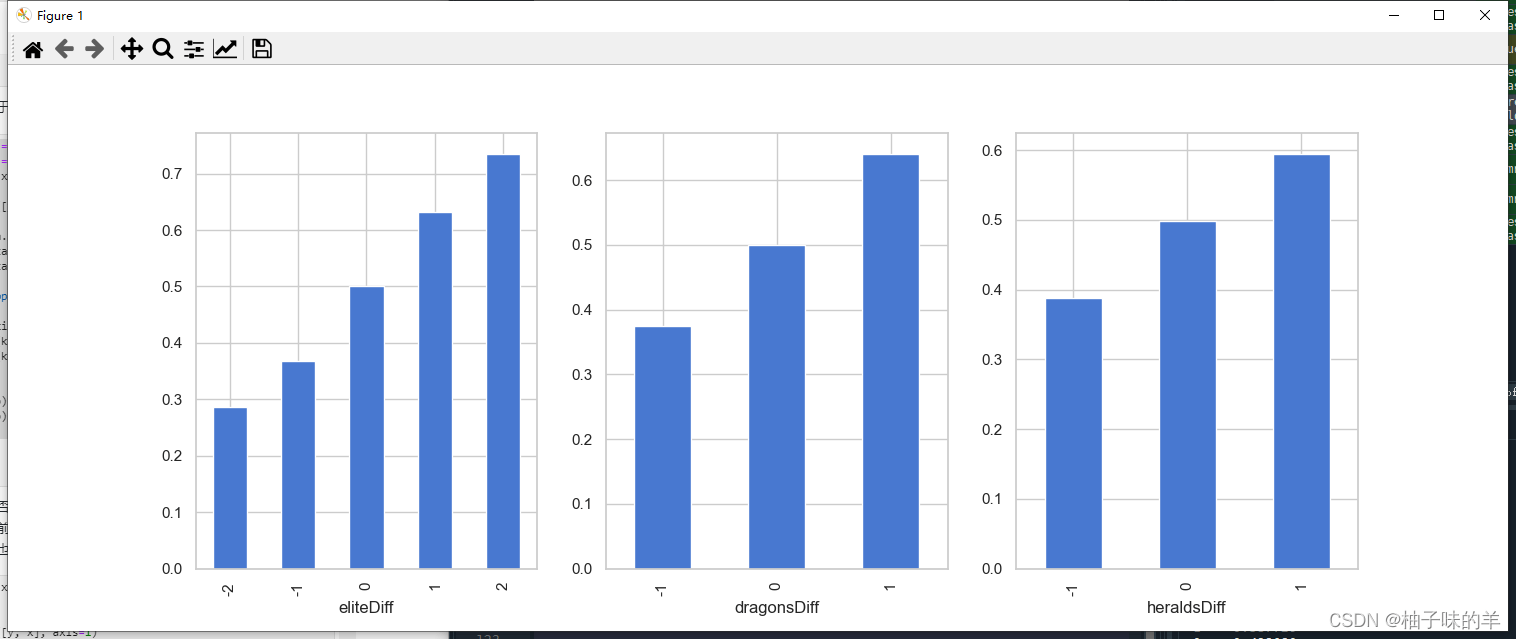
#%%推塔数量与游戏胜负
x['towerDiff'] = x['blueTowersDestroyed'] - x['redTowersDestroyed']
data = pd.concat([y, x], axis=1)
towerGroup = data.groupby(['towerDiff'])['blueWins']
print(towerGroup.count())
print(towerGroup.mean())
fig, ax = plt.subplots(1,2,figsize=(15,5))
towerGroup.mean().plot(kind='line', ax=ax[0])
ax[0].set_title('Proportion of Blue Wins')
ax[0].set_ylabel('Proportion')
towerGroup.count().plot(kind='line', ax=ax[1])
ax[1].set_title('Count of Towers Destroyed')
ax[1].set_ylabel('Count')

#%%利用LightGBM进行训练和预测
## 为了正确评估模型性能,将数据划分为训练集和测试集,并在训练集上训练模型,在测试集上验证模型性能。
from sklearn.model_selection import train_test_split
## 选择其类别为0和1的样本 (不包括类别为2的样本)
data_target_part = y
data_features_part = x
## 测试集大小为20%, 80%/20%分
x_train, x_test, y_train, y_test = train_test_split(data_features_part, data_target_part, test_size = 0.2, random_state = 2020)
#%%## 导入LightGBM模型
from lightgbm.sklearn import LGBMClassifier
## 定义 LightGBM 模型
clf = LGBMClassifier()
# 在训练集上训练LightGBM模型
clf.fit(x_train, y_train)
#%%在训练集和测试集上分别利用训练好的模型进行预测
train_predict = clf.predict(x_train)
test_predict = clf.predict(x_test)
from sklearn import metrics
## 利用accuracy(准确度)【预测正确的样本数目占总预测样本数目的比例】评估模型效果
print('The accuracy of the LightGBM is:',metrics.accuracy_score(y_train,train_predict))
print('The accuracy of the LightGBM is:',metrics.accuracy_score(y_test,test_predict))
## 查看混淆矩阵 (预测值和真实值的各类情况统计矩阵)
confusion_matrix_result = metrics.confusion_matrix(test_predict,y_test)
print('The confusion matrix result:\n',confusion_matrix_result)
# 利用热力图对于结果进行可视化
plt.figure(figsize=(8, 6))
sns.heatmap(confusion_matrix_result, annot=True, cmap='Blues')
plt.xlabel('Predicted labels')
plt.ylabel('True labels')
plt.show()

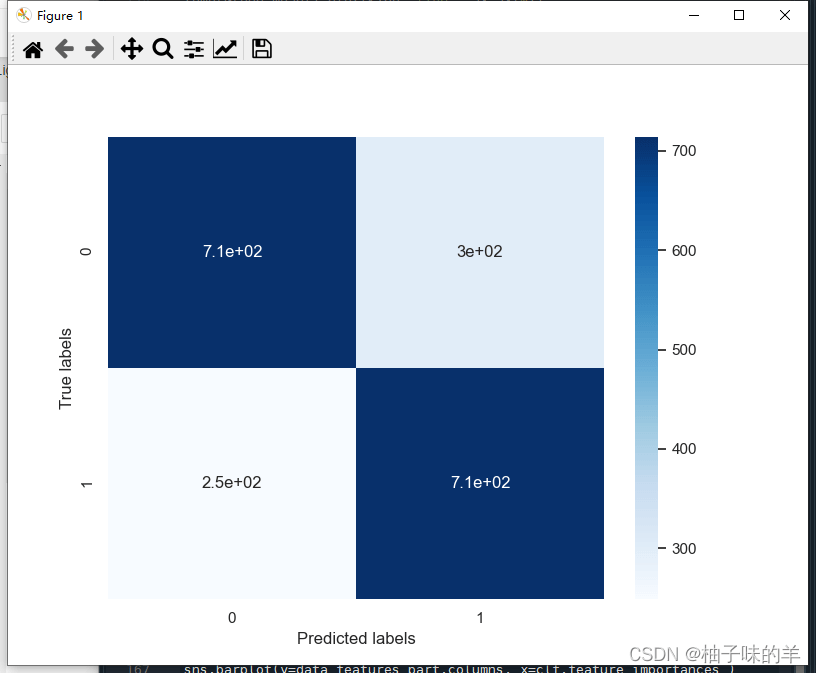
#%%利用lightgbm进行特征选择,同样可以用属性feature_importances_查看特征的重要度 sns.barplot(y=data_features_part.columns, x=clf.feature_importances_)
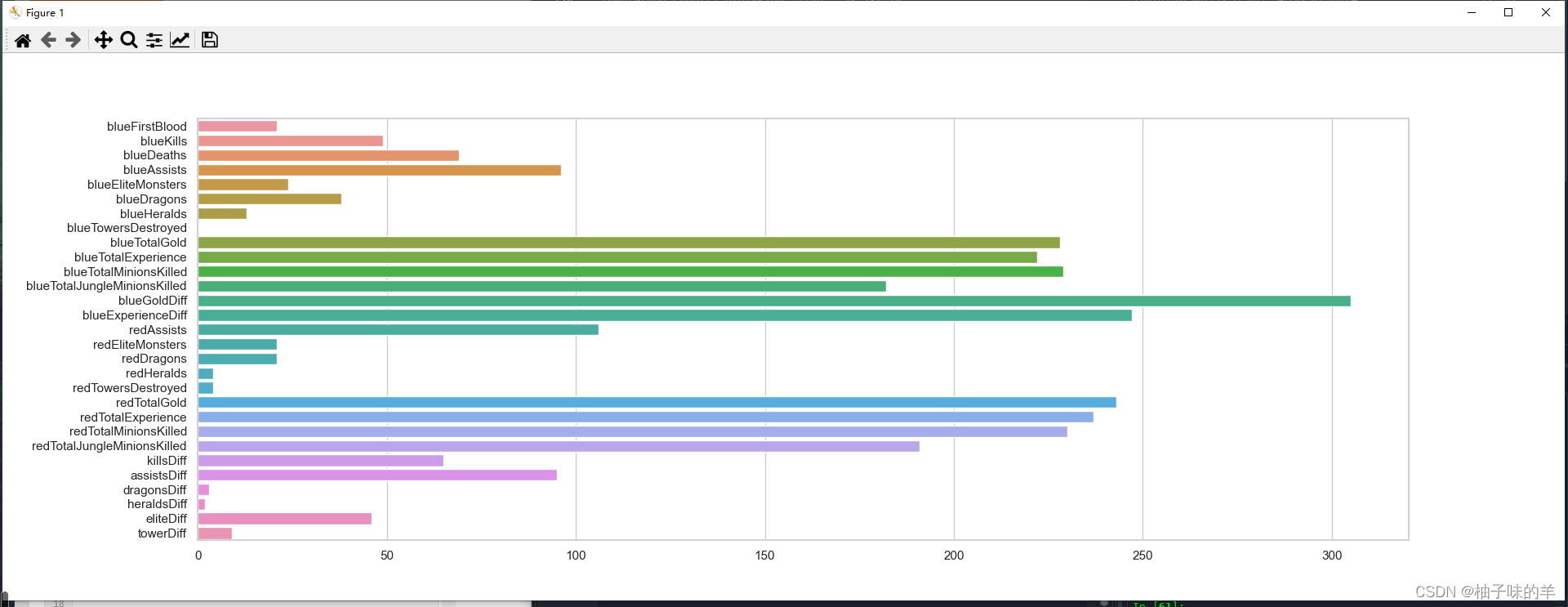
#%%除feature_importances_外,还可以使用LightGBM中的其他属性进行评估(gain,split)
from sklearn.metrics import accuracy_score
from lightgbm import plot_importance
def estimate(model,data):
ax1=plot_importance(model,importance_type="gain")
ax1.set_title('gain')
ax2=plot_importance(model, importance_type="split")
ax2.set_title('split')
plt.show()
def classes(data,label,test):
model=LGBMClassifier()
model.fit(data,label)
ans=model.predict(test)
estimate(model, data)
return ans
ans=classes(x_train,y_train,x_test)
pre=accuracy_score(y_test, ans)
print('acc=',accuracy_score(y_test,ans))
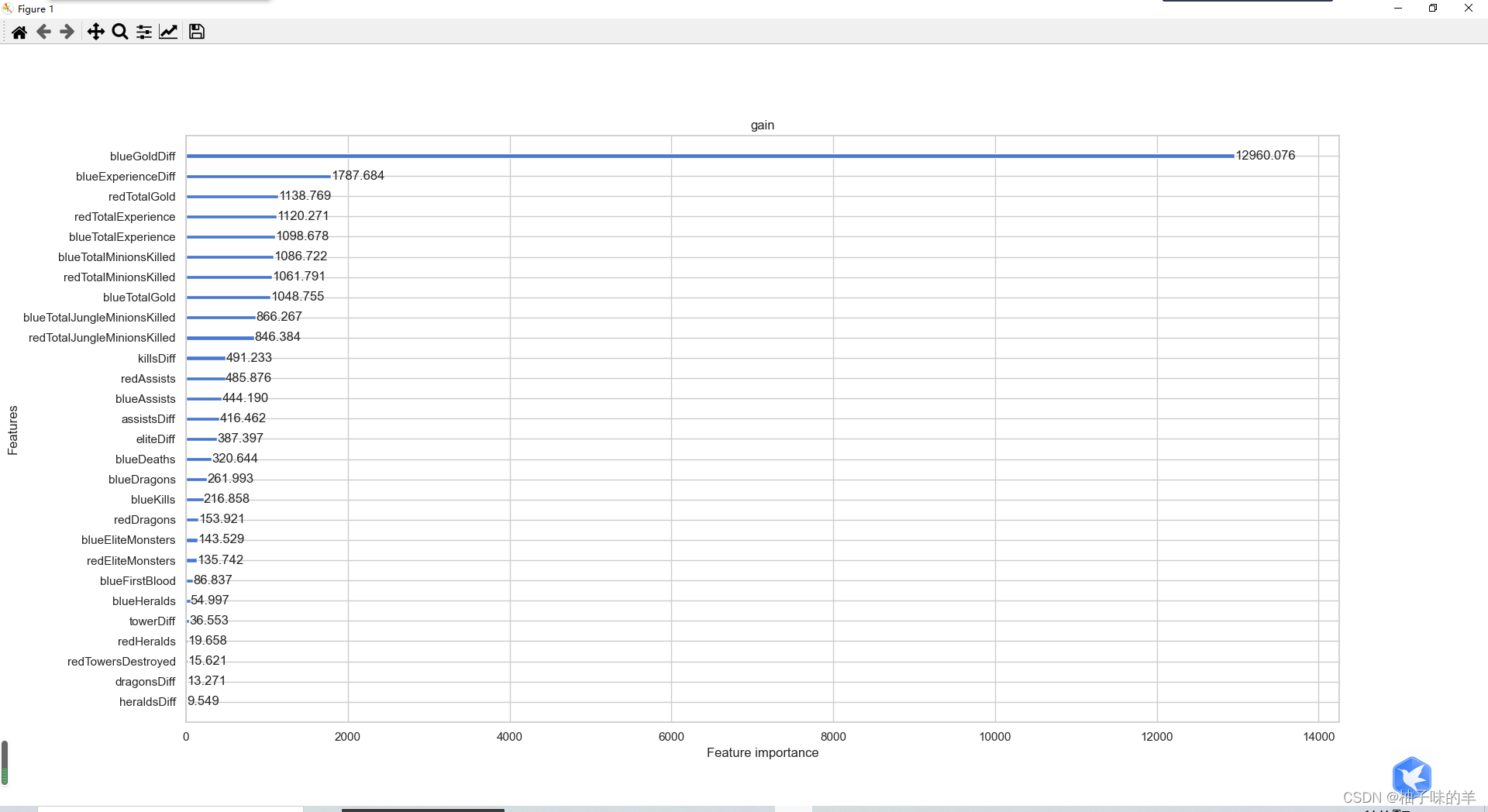

通过调整参数获得更好的效果: LightGBM中重要的参数
- learning_rate: 有时也叫作eta,系统默认值为0.3。每一步迭代的步长,很重要。太大了运行准确率不高,太小了运行速度慢。
- num_leaves:系统默认为32。这个参数控制每棵树中最大叶子节点数量。
- feature_fraction:系统默认值为1。我们一般设置成0.8左右。用来控制每棵随机采样的列数的占比(每一列是一个特征)。
- max_depth: 系统默认值为6,我们常用3-10之间的数字。这个值为树的最大深度。这个值是用来控制过拟合的。max_depth越大,模型学习的更加具体。
#%%调整参数,获得更好的效果
## 从sklearn库中导入网格调参函数
from sklearn.model_selection import GridSearchCV
## 定义参数取值范围
learning_rate = [0.1, 0.3, 0.6]
feature_fraction = [0.5, 0.8, 1]
num_leaves = [16, 32, 64]
max_depth = [-1,3,5,8]
parameters = { 'learning_rate': learning_rate,
'feature_fraction':feature_fraction,
'num_leaves': num_leaves,
'max_depth': max_depth}
model = LGBMClassifier(n_estimators = 50)
## 进行网格搜索
clf = GridSearchCV(model, parameters, cv=3, scoring='accuracy',verbose=3, n_jobs=-1)
clf = clf.fit(x_train, y_train)
#%%查看最好的参数值分别是多少
print(clf.best_params_)

#%%查看最好的参数值分别是多少
print(clf.best_params_)
#%% 在训练集和测试集上分布利用最好的模型参数进行预测
## 定义带参数的 LightGBM模型
clf = LGBMClassifier(feature_fraction = 1,
learning_rate = 0.1,
max_depth= 3,
num_leaves = 16)
# 在训练集上训练LightGBM模型
clf.fit(x_train, y_train)
train_predict = clf.predict(x_train)
test_predict = clf.predict(x_test)
## 利用accuracy(准确度)【预测正确的样本数目占总预测样本数目的比例】评估模型效果
print('The accuracy of the LightGBM is:',metrics.accuracy_score(y_train,train_predict))
print('The accuracy of the LightGBM is:',metrics.accuracy_score(y_test,test_predict))
## 查看混淆矩阵 (预测值和真实值的各类情况统计矩阵)
confusion_matrix_result = metrics.confusion_matrix(test_predict,y_test)
print('The confusion matrix result:\n',confusion_matrix_result)
# 利用热力图对于结果进行可视化
plt.figure(figsize=(8, 6))
sns.heatmap(confusion_matrix_result, annot=True, cmap='Blues')
plt.xlabel('Predicted labels')
plt.ylabel('True labels')
plt.show()

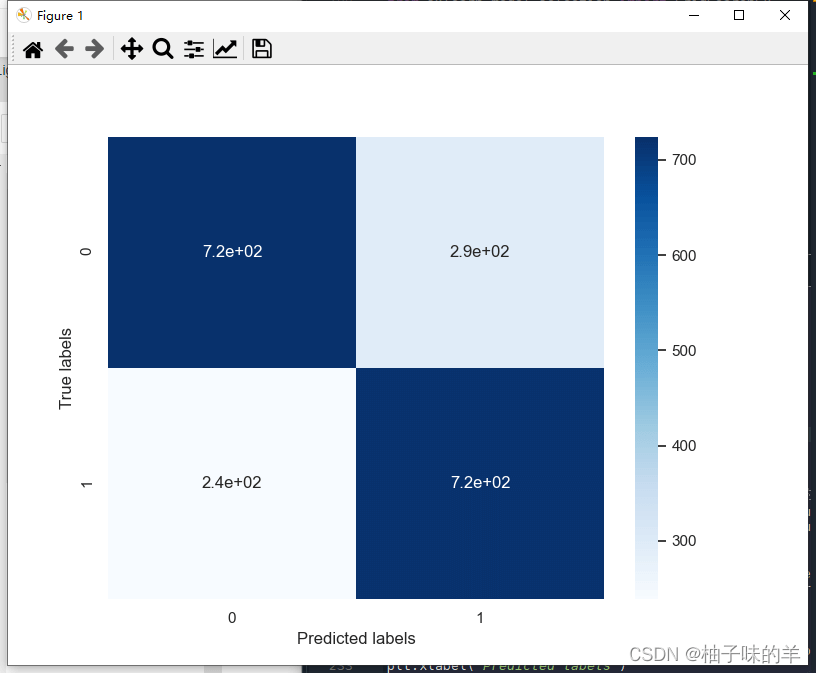
三、Keys
LightGBM的重要参数
基本参数调整
- num_leaves参数 这是控制树模型复杂度的主要参数,一般的我们会使num_leaves小于(2的max_depth次方),以防止过拟合。由于LightGBM是leaf-wise建树与XGBoost的depth-wise建树方法不同,num_leaves比depth有更大的作用。
- min_data_in_leaf 这是处理过拟合问题中一个非常重要的参数. 它的值取决于训练数据的样本个树和 num_leaves参数. 将其设置的较大可以避免生成一个过深的树, 但有可能导致欠拟合. 实际应用中, 对于大数据集, 设置其为几百或几千就足够了.
- max_depth 树的深度,depth 的概念在 leaf-wise 树中并没有多大作用, 因为并不存在一个从 leaves 到 depth 的合理映射
针对训练速度的参数调整
- 通过设置 bagging_fraction 和 bagging_freq 参数来使用 bagging 方法。
- 通过设置 feature_fraction 参数来使用特征的子抽样。
- 选择较小的 max_bin 参数。使用 save_binary 在未来的学习过程对数据加载进行加速。
针对准确率的参数调整
- 使用较大的 max_bin (学习速度可能变慢)
- 使用较小的 learning_rate 和较大的 num_iterations
- 使用较大的 num_leaves (可能导致过拟合)
- 使用更大的训练数据
- 尝试 dart 模式
针对过拟合的参数调整
- 使用较小的 max_bin
- 使用较小的 num_leaves
- 使用 min_data_in_leaf 和 min_sum_hessian_in_leaf
- 通过设置 bagging_fraction 和 bagging_freq 来使用 bagging
- 通过设置 feature_fraction 来使用特征子抽样
- 使用更大的训练数据
- 使用 lambda_l1, lambda_l2 和 min_gain_to_split 来使用正则
- 尝试 max_depth 来避免生成过深的树
最近越发觉得良好的coding habits的重要性!debug才是yyds,从刚学C语言的时候就被老师教育过,当时尝到了debug的甜头,到后来大部分写完即使没有bug的代码还是会debug一遍,现在依然是,希望大家也都养成debug的习惯,当然还有就是写注释,annotation是自己当时的思想,不写后期自己返回来看很大程度时间久了都不知道每个步骤的用意。 886~~~
到此这篇关于Python机器学习应用之基于LightGBM的分类预测篇解读的文章就介绍到这了,更多相关Python LightGBM分类预测内容请搜索好代码网以前的文章或继续浏览下面的相关文章希望大家以后多多支持好代码网!


